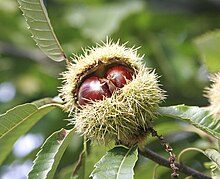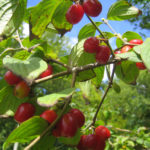Most people don’t consider taste to be one of the senses engaged by a landscape, but including edible plants can make your landscape even more functional and enhance sustainability. Vegetable gardens can be included in your landscape in such a way that they blend with the overall style of your landscape. After all, there isn’t a prerequisite for gardens that says they need to be rectangular! With strategically placed planting areas and stepper paths, gardens can be easily integrated into almost any landscape style and don’t look out of place. Read on for some interesting ideas of edibles you can include in your landscape!
Fruits and nuts are readily available in grocery stores, but there are many hardy fruit and nut bearing plants available in our area (USDA zone 5); Apple, Apricot, Cherry, Peach, Pear and Plum trees, to name a few. Fruit trees require a fair amount of maintenance and can be susceptible to diseases and pests, so keep that in mind while choosing the right variety for you. Small fruits that take up less space include Blackberries, Blueberries, Grapes, Raspberries and Strawberries. Some of these can be tricky to grow, but with the right preparation, conditions, care and patience they will thrive.
There are a number of other edible plants that are sometimes overlooked from an “edible” standpoint, such as Serviceberry and Cornelian Cherry. Serviceberry is a native plant with beautiful ornamental features, such as white flowers in spring and brilliant fall color. But the purple-red fruit that appears around June is mildly sweet with a taste similar to a Blueberry. Birds love these berries as well, and as the saying goes, “if you can get to them before the birds do, they make an excellent pie!”
Cornelian Cherry is actually a Dogwood and is typically included in landscapes because of their beautiful flowers in early spring, but don’t overlook the fruit. Fruit produced by this plant is pear shaped, comes in red or yellow varieties and has a juicy, sweet and tart taste that ripens around August. They are very rich in vitamins and contain more Vitamin C than an orange.
American Hazelnut (Corylus americana) is a shrub that is native to Wisconsin and produces large crops of Hazelnuts in late fall several years after planting. This shrub tends to produce larger quantities of fruit when a different variety of the species is planted nearby for pollination. Growing up to 12’ tall when left to grow naturally, this shrub tolerates full sun to full shade, wet or moist soil and is extremely versatile.
Nut bearing trees produce a wonderful fall treat and are slow growing but become very large, so make sure you have adequate space to accommodate them. They prefer well drained soil and full

Chestnuts
sun, which creates some limitations. Some trees, like the Black Walnut and Butternut, produce a compound called Juglone which is toxic to some other plants. As the tree matures, the area surrounding the tree becomes saturated with Juglone; the older the tree gets, the farther it spreads, with a radius of between 60-80 feet from the trunk. If you have enough space, however, these trees are still an excellent option as a source of nuts in fall.
There are new varieties of Pecan trees that grow in zone 5, but most grow in zones 6-9. As with other nut-bearing plants, most Pecan trees do better with another variety nearby, but there are some cultivars that self-pollinate. Chestnuts also perform better with another variety close by to pollinate with, and even come in a shrub variety that grows up to 12 feet tall. The American chestnut is susceptible to chestnut blight, but there are some hybrids which are partially resistant to it.
The plants we’ve mentioned are just a small handful of the wide array of plants that can further increase the enjoyment you get from your landscape. If you are considering adding edible plants to your landscape, be sure to research your chosen variety before installation so you are fully aware of any drawbacks they may have. Happy harvesting!


